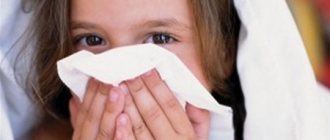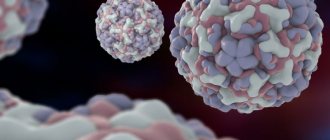A common infectious disease is influenza, but the symptoms in children are often similar to those of ARVI. You should know the manifestations of these two diseases in order to be able to distinguish them in time, diagnose them and begin proper treatment.
ARVI is the most common human disease, so people often start thinking about the flu too late. According to statistics, both diseases cause hospitalization in 33% of all children under the age of 17 years. Moreover, these viral diseases end in death in 7% of cases.
Half of the people who have had the flu in a year are children under 14 years of age. A particularly severe course of the disease, as well as a high probability of developing complications after recovery, is observed in children under the age of 3 years. However, complications can arise at any stage of the disease. That is why it is important for all parents to know how the disease progresses in children.
Ways of spreading the disease
For the virus to enter the body, it needs to gain a foothold in the throat and nasal passages.
The carrier is a sick person with a latent or obvious form of the disease, and he releases the virus into the air through coughing or sneezing. Also, a certain virus is transmitted through objects. For example, a sick child wiped his nose with his hand or covered his cough with his palm, and then asked a friend (desk neighbor, etc.) for a pencil. After this, there is a high probability that a second person may become infected.
As a rule, people think about the flu in the autumn-winter period, since with an average ambient temperature of about +5 ° C and with a decrease in air humidity, favorable conditions are created for the spread of the virus and its penetration into the body.
It’s not for nothing that school-age children are considered a risk group. They are in close contact with peers, and with the flu, the patient is contagious from the first hours, and this continues until about the 7th day of illness.
In this case, the carrier may have a hidden course of the disease, which allows him to spread the virus before the first symptoms appear (2-3 days after it enters the body).
Children can become infected especially quickly when attending an educational institution. After about 2 hours after entering the mucous membrane of a healthy child, the virus begins to penetrate into healthy cells, multiplying in them, and then enters the blood.
When diagnosing, it is customary to adhere to common concepts about the typical and atypical form of the disease. This is necessary in order to know how to treat children in each specific case. The typical form is usually divided into light, medium and severe.
Causes
The main cause of influenza in a child is contact with an infected person. There may be cases of transmission through household items: dishes used by the patient, children's toys, linen, etc. The most dangerous sources of infection are children, in whom the flu occurs in a latent form. A sick child continues normal daily activities, infecting others.
If the influenza virus enters the external environment, it becomes unstable. High temperatures, insolation and disinfectants kill it very quickly.
From the end of the incubation period until the end of the disease, viruses are released into the air during breathing and spread throughout the external environment. The maximum amount of virus is reached on days 3-4, and decreases on days 7-8.
An infant up to 1 month of age has resistance to infection due to the presence of passive immunity received from the mother. If the mother has a weak immune system, the infant may develop the flu in the first month of life. After an illness, a child develops lasting immunity against old serotypes for up to one year.
The causes of influenza are specific RNA-containing microorganisms of a viral nature, the size of which ranges from 80-120 nm. Classification into types A, B and C depends on the matrix protein.
The formulations H1N1 and H3N2, widespread in the media, are just medical classifications of strains.
The media hype caused by bird and swine flu strains has no real basis for concern. Cases of infection from domestic animals are rare. The disease can be transmitted to another animal, and to humans only if the virus mutates. In such a situation, the flu has completely different symptoms and the treatment will also be different.
Symptoms and course of a typical flu
After infection, an incubation period begins, which in childhood can last from several hours to 3 days.
The average is 1-2 days. At this time, it is difficult to detect the disease, since the symptoms of the virus are not visible in the child. Typical influenza manifests itself as toxicosis (this is a specific influenza intoxication) and in the form of catarrhal phenomena of the upper respiratory tract. The disease develops rapidly, with acute manifestations of fever and an increase in body temperature to 38-40 °C. The most common symptoms during a fever are:
- specific intoxication, which manifests itself in the form of a headache in the temple area;
- discomfort in the eyeballs;
- pain in muscles and joints;
- severe weakness throughout the body;
- pallor;
- decreased appetite with possible vomiting.
Children under 1 year of age may have seizures at the peak of a fever.
At the age of up to 3 months, children have so-called passive immunity, which is passed on to them by their mother, so during this period babies usually do not get the flu. However, if the mother did not have enough antibodies in her body, then this age group is also susceptible to infection. The main symptoms of complex forms of the disease may be accompanied by impaired consciousness. They manifest themselves in the form of delusions and hallucinations. If a child gets the flu, he may develop rhinitis. The latter is accompanied by profuse swelling of the nasal mucosa, soft palate, and tonsils. Granularity of the back of the throat is also a characteristic sign of influenza, and treatment in this case should also be symptomatic.
Tracheitis often develops, which may be accompanied by a dry cough. The pain with the latter is felt during the passage of air through the trachea and behind the sternum. Laryngotracheitis may develop, which occurs with the development of inflammation, the presence of pus in the nose and throat.
Harsh breathing may be accompanied by dry wheezing. The severe course of the disease can occur with the development of toxicosis and simultaneous damage to the central nervous system.
There may be heavy bleeding from the nose, the presence of petechiae - flat, round, red, pinpoint spots on the mucous membranes and skin.
How to treat flu in a 4 year old child?
Answers:
Julia
High temperatures can be brought down using ordinary vinegar. Dilute it with cold water and wipe your neck, shoulders, arms, and armpits with the cold solution. Gargling will help relieve a sore throat. For one glass of water, take 1 teaspoon of salt and 10 drops of iodine. The solution is ready. The substances contained in honey help dissolve and remove mucus that forms in the lungs during bronchitis, flu and colds. — Dilute 5 tbsp in 1 liter of boiled water. spoons of honey and add the oriental spice turmeric powder on the tip of a knife, stir well. A day you need to drink at least three glasses of this pleasant-tasting healing drink, each time preheating it to a moderately hot temperature. - Mix 1 tbsp. a spoonful of uncandied honey with a small amount of milk. Hold this mixture in your mouth close to your teeth for at least 5 minutes, making sure it washes the front third of your tongue. The procedure can be performed twice a day for 4-5 days. — For flu and colds, mix horseradish juice with honey in a 1:1 ratio and take 1 tbsp. spoon 3-4 times a day, washed down with warm water. For a cold cough, it is recommended to drink cranberry juice with honey in a 1:1 ratio.
Marina SPb
Doctor! Listen to the child!
~+MaRiYgO+~
buy stopangin just in case, it helps me too, only my sister got sick and my daughter is also a baby
Personal Account Removed
It’s better to ask this question not here, but to a doctor. they can recommend something like this...
Personal Account Removed
The doctor needs to be called
VL
doctor first! and don't delay. I treat my 4-year-old son with Arbidol - it helps a lot. Then we’ll also hire profozha prevention, it lasts even when everyone at home is sick. and he got a little sick - he was giving me an attack of croup!
Elena Skaskova
To treat the disease itself, antiviral drugs are necessary, because Arbidol-lance (for children), can be homeopathic because oscillococcinum (there are no side effects from it, but the effect is amazing) And to relieve the symptoms of the disease, Nurofen (syrup) or Panadol or other syrups for children.
Maria
Call a doctor, there is nothing worse than self-medication, but in the meantime, tea with raspberries, woolen socks on your feet and in bed, as soon as you sweat, change your clothes immediately
fidget
I use wormwood. I dry fumigate the apartment, and drop 2 drops of oil onto an incandescent lamp. Disinfection occurs and the sick person recovers quickly, and the healthy one does not get sick. My children rarely get sick, no more than once every 2 years. Tea made from the leaves and bark of obdepikha helps well. When my son had a temperature of under 40, I brewed it and drank it instead of water. On the first day the temperature became 37, on the second it was not there but he sniffed. On the third they forgot about the illness
Signs and course of atypical influenza
This manifestation of influenza is usually classified as erased and hypertoxic forms. During the second, body temperature can reach 40 °C. Moreover, the first symptoms of intoxication are very pronounced, the following is observed:
- infectious shock;
- cerebral edema;
- toxicosis of the nervous system;
- development of hemorrhagic pneumonia.
Complications
Severe consequences of influenza are distinguished by:
- time of their development;
- localization;
- etiology (bacterial or viral).
The most common complication is pneumonia. It is divided into primary (viral, which develops in the first 48 hours after infection with influenza) and secondary. The latter is also called bacterial, and acute otitis media can also appear simultaneously with it.
Parents should know how to recognize influenza complicated by pneumonia. This form of the disease is extremely difficult and requires immediate treatment.
Pneumonia is characterized by acute signs of respiratory failure, wet or dry rales in the lungs, which are easily audible. In this case, focal shadows can be detected on x-rays. When a bacterial infection is attached, bacterial pneumonia can quickly develop. Provocateurs are chlamydia, streptococci, staphylococci, Pseudomonas aeruginosa, etc.
At an early age, influenza is often complicated by pneumonia, which in 60% of cases develops immediately after infection. Body temperature rises to 39-40 °C, symptoms of bronchitis and shortness of breath appear.
Identification of this set of symptoms is the basis for the patient to be admitted to an infectious diseases hospital for additional treatment using antibiotics.
What should the therapy be like?
The main tasks in the treatment of influenza:
- timely suppression of viral activity, it may be necessary to admit the child to a hospital;
- prevention of complications, and if they occur, treatment until complete recovery;
- raising the patient's general immunity.
The child can be treated at home if the course of the disease does not suggest complications.
Pain when coughing is felt as air passes through the trachea and behind the sternum. Laryngotracheitis may appear, which occurs with the development of inflammation in the form of pus in the nose and throat.
First of all you need to:
- Maintain bed rest. For the first 2-3 days, children need to stay in bed as long as possible to alleviate the symptoms of “withdrawal” in the body.
- Stick to a diet. During the period of illness, it is necessary to eat more vegetables and fruits, and drinking plenty of fluids will alleviate symptoms and treatment, and cope with intoxication more quickly. It is recommended to give your child plain water, which will help cleanse the body. Since it is not possible to quickly cure the flu with the help of medications alone, the child needs to drink rosehip infusion, tea with honey and lemon. You can make him freshly squeezed fruit juice or cook compote. Sweets containing refined sugar should be excluded from the diet during illness, as they can suppress the immune system.
- The doctor should tell you in detail what to do if the child’s temperature reaches 38 °C. Antipyretics are usually prescribed, and if they are ineffective, it is recommended to call an ambulance.
- Treatment of influenza is impossible without the use of antiviral drugs, and they must be relevant for the current season. A set of drugs is prescribed by a doctor.
- At the slightest suspicion of complications, you should call an ambulance or visit the hospital yourself.
- The child should be in a well-ventilated room.
- Every evening it is necessary to bathe the patient in the shower. The water should be warm. This procedure will wash away viral toxins from the body.
Treating flu symptoms in children
It is worth remembering that the flu is not a cold; you will not be able to rest, especially given the weakened child’s body. Medicines will most likely be required.
However, preventive measures, especially those associated with the treatment of colds, are still relevant. It is necessary to ventilate the room, drink plenty of water, and try to reduce the ambient temperature. The main condition for treatment is bed rest, thanks to which the immune system can focus on fighting the virus without being distracted by other things and reducing the risk of complications.
Prevention
To protect your child from the flu, you should take preventive measures, which include:
- Vaccination. The peculiarity of the infection is its versatility and the mutations necessary to penetrate the human body. In this regard, it is very important to vaccinate your child in a timely manner every year. You need to know that vaccination is carried out to prevent infection, and not to cure an already acquired disease.
- Refrain from attending educational institutions during the peak period of virus activity. At the same time, you should not have contact with sick children outside of school.
- Carrying out regular wet cleaning in the children's room. It is necessary to wash floors and wipe dust using a 1% chloramine solution at least 2 times a week.
- Air humidification. You should purchase a special device for this. It should be used in the autumn-winter period.
What to do to prevent your child from getting the flu? It is imperative to strengthen the immune system. To do this, you should walk outside more often and spend less time at the computer, especially in the summer. For good immunity, psychological health is also important; there should be a favorable atmosphere in the family.
Proper nutrition and the use of vitamin complexes will also have a beneficial effect on the child’s health.












